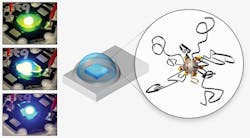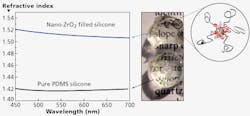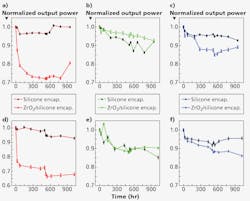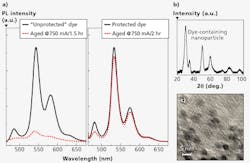Engineered nanoparticles enable higher LED efficiency and improved color conversion (MAGAZINE)
YING LI,BHARATH NATARAJAN, GLENN HORNER, LINDA SCHADLER, and ROBERT KARLICEK describe a new nano-zirconia-based LED encapsulation material that promises improved packaged LED efficiency and potentially integrated color conversion.
Increased demand for energy-efficient lighting is accelerating the broad adoption of LED-based lighting products, while the LED industry continues to pursue even greater efficiency. At the LED package level, LED operating efficiency can be increased by using higher-index encapsulants. This article presents a highly-integrated functional encapsulant material based on specially modified nano-zirconia composites, which not only enhance light extraction but open a broad new range of encapsulant engineering capabilities for improved control of color conversion and overall LED package performance.
Refractive index engineering
Ever since the invention of visible LEDs in the 1960s, maximizing the refractive index of the LED encapsulant used for packaging has been recognized as a key part of maximizing luminous efficacy. Higher index encapsulants reduce total internal reflection (TIR) at the interface between the LED chip and the encapsulation material. Initially, high-index epoxies were used for longer-wavelength LEDs, but lower-index silicones were quickly adopted for GaN-based LEDs (including white) because typical LED packaging epoxies tended to yellow with prolonged exposure at wavelengths below about 500 nm, resulting in reduced operating lifetime.1
Ideally, nearly perfect light extraction can be obtained when the encapsulant index closely matches the refractive index of the LED chip. But a combination of high indices for LED semiconductor compounds, ~2.3 for GaN-based LEDs and ~3.3 for AlInGaP LEDs, and low indices for optically clear organic encapsulants makes this ideal optical arrangement impossible to achieve.
To minimize the refractive index difference between the LED die and the surrounding LED encapsulant, various approaches have been developed. Focusing on the encapsulant chemistry alone, constituents with high molar refraction and low molar volumes can be introduced, including aromatic rings, sulfur-containing groups, halogens (except fluorine), and organometallic materials with highly polarizable p-conjugated structures. However, other encapsulant LED requirements, including low optical absorption, good photothermal stability, and suitable mechanical properties and processability typically limit the upper refractive index obtained through purely chemical means to values well below 1.6.
It is also possible to increase an encapsulant's refractive index by adding transparent nanoparticles made from high-index inorganic materials. The resulting refractive index of the encapsulant/nanoparticle composite is a weighted average of the low-index matrix and the high-index nanoparticles. Good optical clarity can be achieved if the nanoparticle agglomeration can be eliminated. Agglomeration is a phenomenon in which nanoparticles stick together to make larger, light-scattering particles. Previous work on index engineering of LED encapsulants has focused on the use of nano titanium dioxide (TiO2). But while indices as high as 1.8 have been demonstrated using epoxy/TiO2 composites2, such materials have typically exhibited poor optical stability, and therefore are not used in packaged LEDs.
This work describes new approaches to enhanced nanoparticle composite refractive index engineering using nano-zirconia (nano-ZrO2). Using advanced nanoparticle engineering, high-index nanoparticle/silicone composites with good photothermal stability and high optical clarity have been developed. Perhaps more importantly, the chemistries used to optimize nano-ZrO2 for use in silicone composites open up a new set of highly stable color-conversion technologies based on organic dyes that can be integrated directly into the nanoparticle structure. These new composite encapsulants combine improved light extraction through index engineering with non-scattering color conversion technology to open new pathways to highly efficient white LEDs.
How it works
The technical challenge to the successful implementation of this nano-ZrO2 approach lies primarily in maintaining superior clarity of the hybrid encapsulant while achieving as high a nanoparticle loading as possible. For encapsulant thicknesses used in LED packaging, the size of the nanoparticles needs to be less than 10 nm to minimize opacity for short-wavelength light below 500 nm.3
Conventional approaches to uniformly dispersing inorganic nanoparticles within a polymer matrix utilize matrix-compatible polymer ligands attached to nanoparticle surfaces. The sometimes-called "polymer brush" approach shields the nanoparticle surfaces from each other and prevents agglomeration. However, within commonly used silicone encapsulants, this shielding effect can be problematic, because the surface-modified inorganic nanoparticles tend not to wet the host silicone, eventually leading to precipitation of nanoparticles. To maintain good nanoparticle separation and simultaneously achieve stable incorporation in the encapsulant, polymer brushes with a bimodal population (Fig. 1) have been developed.4-6
The bimodal population consists of a densely-grafted short brush that effectively screens the inorganic nanoparticle surfaces, and a sparsely-grafted long brush that allows penetration of host polymers into the brush layer to improve solubility. Note that the ligand brush density near the nanoparticle surface plays a more important role in dispersion control. Therefore, reducing ligand graft density further away from the particle surface can minimize the use of ligand materials and increase the achievable filler loading without deteriorating clarity of the filled encapsulants.7 As shown in Fig. 1, the bimodal brush modified nano-ZrO2 (n = 2.2, ~4 nm in diameter) filled silicone exhibits both high index and good clarity compared to pure silicone (n = 1.41). The increase in refractive index of the encapsulant gives more than a 7% light extraction enhancement even for surface-roughened high-power LEDs.
Since the overall index of the composite depends on its filler loading, graded-index lens structures can also be constructed by sequential deposition of composites with an appropriate range of filler loadings. By grading the refractive index (high near the LED chip, low at the lens-air interface), graded-index lens designs can be used to further enhance the LED package light extraction efficiency, achieve better control of the far-field emission pattern, and improve management of far-field color uniformity.
Preliminary reliability testing
To evaluate the stability of the high-index hybrid encapsulant, preliminary aging tests were conducted under ambient conditions at a variety of operating currents. Red, green, and blue power (1W) LEDs were obtained, packaged in a molded lead frame format and mounted on a standard hex metal-clad printed-circuit board (PCB), but without any encapsulation. These devices were encapsulated manually with both unmodified and nanoparticle modified (~53 wt% or weight percent loading) silicone using a simple mold form.
Two sets (N = 2 per wavelength) of encapsulated LEDs were aged at room temperature under different operating currents as shown in Fig. 2. The first set of LEDs were mildly driven at 100 mA for 500 hours and then 350 mA for 500 hours to look for current/temperature-related aging effects. The second set of LEDs was driven more aggressively, starting at 500 mA for 500 hours followed by an additional 500 hours at 1000 mA. This stepped current sequence was selected to bypass any short-term degradation related to the manual packaging operation.
As shown in Fig. 2, the green and blue LEDs showed very little aging, maintaining more than 85% of optical output at 1000 hours, even though the blue LEDs with the highest photon energy could more easily cause photochemical degradation of the nanocomposite encapsulant. In particular, optical output changes upon changing operating currents at 500 hours for each set of LEDs showed no significant acceleration of optical output degradation. While much more exhaustive reliability testing will be required for commercial adoption of nano-ZrO2-filled silicones in LED manufacturing, these initial results are very encouraging, and even better results are expected with improved nano-ZrO2 synthesis and automated LED packaging operations.
Surprisingly, major output degradation was observed for both sets of red LEDs encapsulated with nanocomposite silicones. This degradation stabilized at ~70% lumen output after 300 hours and further deterioration out to 1000 hours was not significant (~5%) even at elevated drive currents. It is suspected that the red AlGaInP die and current spreading contact materials are much more sensitive to surface chemical reactions than GaN LED die, and it is possible that the organic components, residual impurities left from the nanoparticle synthesis, attack the red die surfaces.
It is known from optical analysis of the composite encapsulant used in this study that trace amounts of some organic reagents used in the nano-ZrO2 synthesis were not fully removed. Improved synthetic methods are now under development. It is worth noting that, since the organic impurities give a slight yellow color, their complete removal can also be especially beneficial for enhancing blue LED efficiency due to simultaneously reduced blue light absorption and scattering losses.
Nanocomposites for color conversion
Based on controlled nano-ZrO2 dispersion, the versatility of this approach facilitates creation of an entire toolbox for advanced functional LED encapsulants.8-9 One novel application, described here in a proof-of-concept demonstration, shows how organic fluorescent dye molecules can be incorporated onto the nano-ZrO2 platform. Individual fluorescent molecules can be attached onto nanoparticle surfaces, or "clicked" to the backbone/side chain of the polymer brushes. Such rare-earth-free non-scattering down-converters offer a promising alternative to commercial inorganic phosphors such as cerium-doped yttrium aluminum garnet (YAG:Ce), silicates, and nitrides. Such materials are widely used in phosphor-converted LEDs, as shown in Fig. 3.
In addition to enhanced packaged LED light extraction due to the increased refractive indices and elimination of scattering losses, tying organic phosphors to the nanoparticles reduces intermolecular quenching, leading to higher efficiency, and improves reliability by eliminating common dye molecule degradation modes. For high-color-rendition applications, the unique advantage of this approach is the ability of fine spectral tuning via dye molecular design and uniform color mixing. It has been demonstrated that high CRI (>90) white light with high R9 values (>90) can be obtained with blue LEDs and a series of ultrastable rylene dyes.
Another potential value of this toolbox lies in the molecular-level incorporation of the organic dye molecule into the crystalline zirconia, providing an important stabilization mechanism that enhances the reliability of the hybrid down-converters, even when the dye is relatively unstable in the presence of blue light. In this process, the dye is introduced in-situ during the synthesis of the nano-ZrO2 and is partially incorporated into the nanoparticle.
The impact of nanoparticle incorporation on the dye reliability is stunning. As shown in Fig. 4, without incorporation into nanoparticles, a broadband organic dye exhibits fast degradation after processing, while dye molecules integrated into the nano-ZrO2 demonstrate nominally stable operation. As also shown in Fig. 4, the crystalline structure of nano-ZrO2 was not impacted by the addition of the dye. While these results are preliminary, this technology opens a new path for the synthesis of non-scattering, rare-earth-free, highly reliable color converters.
Beyond index engineering and novel approaches to organic dye color-conversion systems, the nano-ZrO2 material system opens an entirely new path to exotic optical systems fabrication. One important example involves the introduction of crosslinkable moieties onto the polymer brush.7 Since the modified transparent nano-ZrO2 can be held together by the surface-bound polymer brush alone, no additional host silicone is needed.
This generalized approach not only eliminates the use of matrix, and therefore ultimately maximizes the filler loading, but also enables the precise control of longer-range spatial organization of the refractive index, or any other functionalities carried by the nano-ZrO2. This includes the use of 3D printing, laser writing, or stamping technologies to generate novel color-mixing lens structures in multi-die LED packages as well as other new nano-engineered approaches to fabricating high-performance optics for lighting systems.
Summary
A new nanocomposite encapsulant toolkit for packaged LEDs has been developed. Both high-refractive-index engineered nanocomposite silicones with good reliability and optical clarity have been demonstrated through careful engineering of the nanoparticle synthetic process. In addition, the versatility of this toolkit is demonstrated by attaching organic dye down-converters to the nanocomposite silicones for white packaged LED applications. While this work is preliminary, continued refinement of this technology platform offers exciting new approaches to improved performance and manufacturing of solid-state lighting systems.
ACKNOWLEDGMENTS
This work was performed at the Rensselaer Polytechnic Institute (RPI) Smart Lighting Engineering Research Center and was supported primarily by the Engineering Research Centers Program of the National Science Foundation under NSF Cooperative Agreement No. EEC-0812056 and in part by New York State under NYSTAR contract C090145. The authors gratefully thank Prolight Opto Technology Corporation for providing un-capped LEDs, and Charles S. S. Goodwin for help with aging tests. We also thank Professor Chaitanya Ullal for inspiring discussions.
REFERENCES
1. Y.-Q. Li, Y. Yang, and S.-Y. Fu, "Photo-Stabilization Properties of Transparent Inorganic Uv-Filter/Epoxy Nanocomposites," Compos. Sci. Technol., 67, pp. 3465-3471 (2007).
2. P. Tao et al., "Tio2 Nanocomposites with High Refractive Index and Transparency," J. Mater. Chem., 21, pp. 18623-18629 (2011).
3. W. Caseri, "Nanocomposites of Polymers and Metals or Semiconductors: Historical Background and Optical Properties," Macromol. Rapid Commun., 21, pp. 705-722 (2000).
4. Y. Li, P. Tao, A. Viswanath, B.C. Benicewicz, and L.S. Schadler, "Bimodal Surface Ligand Engineering: The Key to Tunable Nanocomposites," Langmuir, 29, pp. 1211-1220 (2012).
5. A. Rungta et al., "Grafting Bimodal Polymer Brushes on Nanoparticles Using Controlled Radical Polymerization," Macromolecules, 45, pp. 9303-9311 (2012).
6. S.K. Kumar and R. Krishnamoorti, "Nanocomposites: Structure, Phase Behavior, and Properties," Ann. Rev. Chem. Biomol. Eng., 1, pp. 37-58 (2010).
7. Y. Li et al., "Bimodal 'Matrix-Free' Polymer Nanocomposites," RSC Advances, 5, pp. 14788-4795 (2015).
8. Y. Li et al., "Organic Phosphor-Functionalized Nanoparticles and Compositions Comprising the Same," PCT/US2014/032531 (Oct. 9, 2014).
9. Y. Li, L.S. Schadler, C. Ullal, C.S.S. Goodwin, and R.F.J. Karlicek, "Cross-Linkable Matrix-Free Nanocomposites with Tunable Optoelectronic Functionalities and the Methods for Their Macro-, Micro- or Nano-Structures Construction," US Patent Pending.
YING LI is a materials engineer - illumination delivery systems, Performance Indicator, LLC; BHARATH NATARAJAN is a postdoctoral fellow, National Institute of Science and Technology (NIST; previously a doctoral student of Rensselaer Polytechnic Institute, RPI); GLENN HORNER is vice president - project management, Performance Indicator, LLC; LINDA SCHADLER is a professor of Materials Science & Engineering and ROBERT KARLICEK is director at the Smart Lighting Engineering Research Center and a professor of Electrical, Computer and Systems Engineering at RPI (http://smartlighting.rpi.edu).








